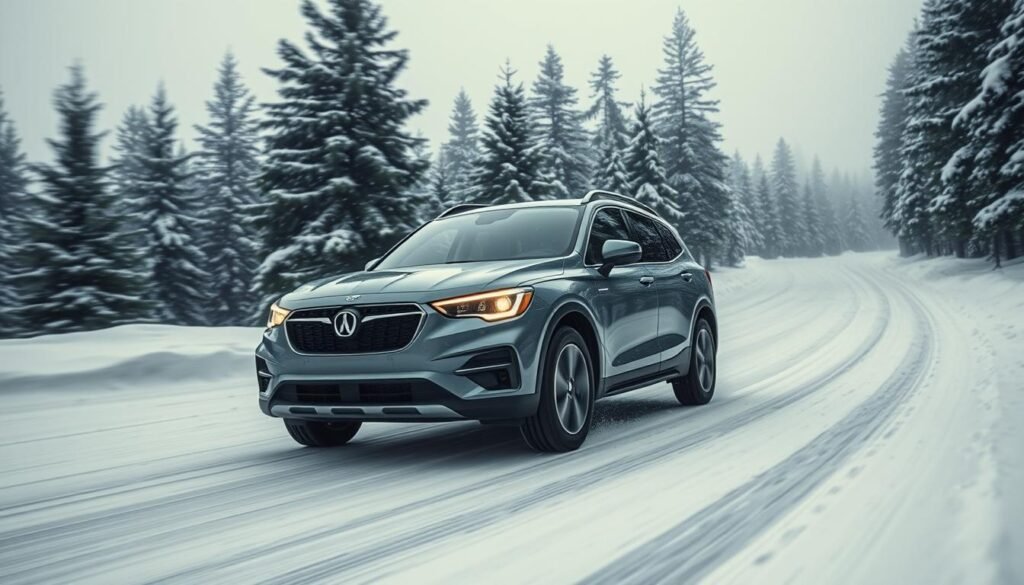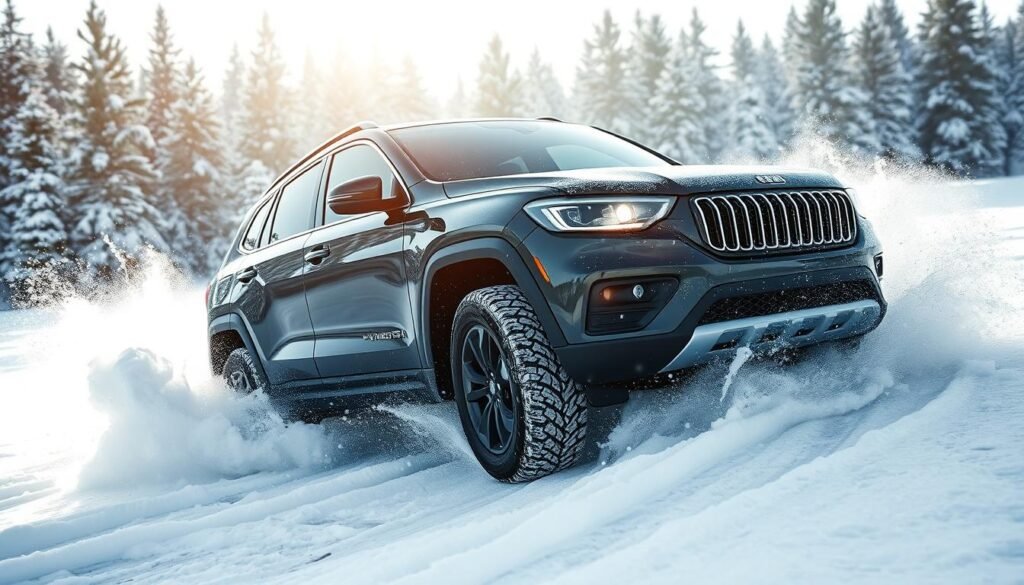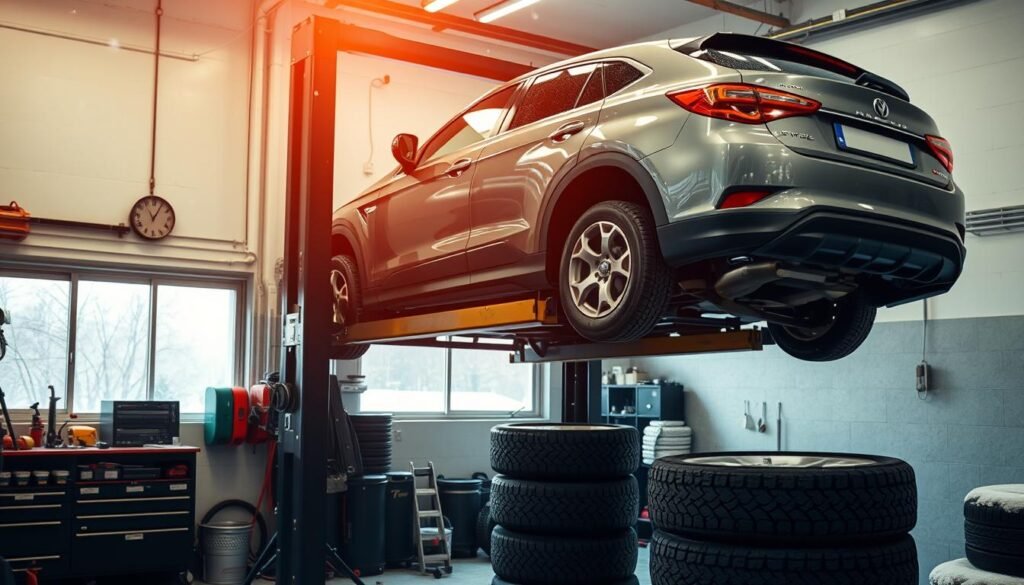Are you wondering if your front-wheel drive (FWD) vehicle can handle winter weather? You might be surprised to find out that FWD cars can do well in snow. This is because the weight is mostly on the driving wheels1.
Front-wheel drive vehicles have more weight on the front tires. This gives them better traction and control on snowy roads. But, there are some limits to FWD in winter driving that you should know about.
Key Takeaways
- FWD cars offer good traction and control in snowy conditions due to the weight distribution over the front wheels.
- FWD vehicles may struggle with acceleration compared to all-wheel drive (AWD) or 4-wheel drive (4WD) cars1.
- Snow tires can significantly improve the performance of FWD cars in winter weather1.
- All-season tires may not provide adequate grip in severe snow, while snow-rated all-season tires can be a suitable compromise1.
- Proper driving techniques, such as gentle acceleration and braking, are key for FWD vehicles in snowy conditions1.
The Advantages of FWD in Snowy Conditions
Front-wheel drive (FWD) cars do well in snow, thanks to several benefits. Most of a FWD car’s weight is on the driving wheels. This gives better traction and easier control on icy roads2.
This weight helps FWD cars stay stable and avoid fishtailing in snow2.
Improved Traction and Easier Control
FWD cars might not speed up as fast as AWD or 4WD in snow. But, they have better traction and are easier to handle2. Adding snow tires makes FWD cars even better at braking and turning, beating AWD or 4WD with all-season tires2.
Snow tires stay soft and grip better in cold weather. This is why FWD cars are good at handling snow3.
Cost-Effective and Fuel-Efficient
FWD cars are also cheaper to buy and maintain4. They have fewer parts than AWD or 4WD systems. This means lower costs upfront and over time4.
They are also lighter, which helps them use less fuel than all-wheel-drive cars4.
Unless you live where snow blocks roads, a FWD car with winter tires is fine2. Just drive carefully and stay home if it’s too bad2.
In short, FWD cars are a smart choice for those facing moderate snow. With the right winter tires, they offer great traction and control. This makes them a good option for many snowy areas234.
Snow Tires vs. All-Season Tires
Choosing the right tires for your front-wheel drive (FWD) car is key in snowy weather. Snow tires are made for cold, snowy, and icy roads. They have special rubber and tread for better grip5. All-season tires are good for mild winter but not as good as snow tires in snow and ice6.
Snow tires offer clear benefits. A FWD Mini with snow tires stopped shorter than an AWD Mini on all-season tires in snow5. It also handled better, showing snow tires’ grip and control5.
| Metric | FWD on Snow Tires | AWD on All-Season Tires |
|---|---|---|
| Snow Braking | Stopped a car-length shorter | – |
| Acceleration | Slightly quicker | Confidently pulls away |
| Handling | Slightly quicker | Better acceleration out of corners, worse braking and turn-in |
All-season tires aim for a balance in different weather conditions6. They’re okay for light winter driving but not for heavy snow and ice6. Winter tires, made for cold and snowy conditions, offer better grip and control6.
Choosing between snow tires and all-season tires depends on your area’s weather6. If you face heavy snow and icy roads often, winter tires are safer and better for your FWD car56.
How to Drive Safely with FWD in Snow
Driving in the snow with a front-wheel drive (FWD) car needs care and knowledge of your car’s limits. Use smooth, gentle driving to keep your car stable and in control. This ensures a safe trip through winter weather78.,
Driving Techniques and Tips
When driving in the snow, make sure to use smooth, gradual movements. Avoid sudden or harsh actions that can make the front wheels slip. Instead, drive calmly, letting your car adjust to the road8.
It’s also key to drive at the right speed. FWD cars can handle snow better than some others, but they have limits8. Drive slowly and keep a safe distance from other cars to stop on time7.
What to Do When You Start Sliding
If your car starts sliding, don’t hit the brakes hard8. This can make things worse. Instead, slowly steer in the direction you want to go. This helps the front wheels get traction again7.
Disabling traction control might help if you’re stuck in deep snow7. Also, try rocking your car gently by pressing the gas and then reversing. This can help get unstuck7.

By following these tips, you can drive safely in snowy conditions with your FWD car789.,,
is front wheel drive good in snow
Front-wheel drive (FWD) can be a solid option for driving in snowy conditions, thanks to high-quality winter tires. The front wheels’ weight and traction often give FWD vehicles an edge over rear-wheel drive cars in snow and ice10. FWD cars handle well in snow because most of their weight is over their driving wheels, giving the front tires more grip10.
The performance of a FWD car in snow depends on the driver’s skill, the weather, and the vehicle’s features10. FWD cars are slower to accelerate in snow compared to AWD or 4WD cars10. But, with the right tires and driving techniques, FWD can be a capable and cost-effective way to navigate snowy roads.
- Snow tires can help FWD cars brake, turn, and accelerate better in snow compared to all-season tires10.
- Snow tires are designed to stay pliable and grip in cold weather, providing easier traction in snow10.
- FWD cars equipped with snow tires often outperform AWD or 4WD cars with all-season tires in snowy conditions10.
- All-season tires may struggle in cold weather and snow due to hardness and lack of grip compared to snow tires10.
- Snow-rated all-season tires meeting the “Three-Peak Mountain Snowflake” symbol have improved winter performance compared to non-rated tires but are less capable than dedicated snow tires10.
In general, FWD with winter tires is a capable and cost-effective solution for snowy roads10. FWD cars are good for driving in snow, unless facing very heavy snowfall or driving on unplowed roads often10. When driving in snowy or icy conditions, slow down, keep distance, brake gently, and accelerate smoothly to avoid skids and accidents10. If a car starts sliding in snowy conditions, gently releasing the brakes is recommended to regain control and avoid using up tire grip10.
| Drivetrain | Advantages | Disadvantages |
|---|---|---|
| Front-Wheel Drive (FWD) |
|
|
| All-Wheel Drive (AWD) |
|
|
| Rear-Wheel Drive (RWD) |
|
|

In summary, front-wheel drive can be a good option for driving in the snow, thanks to winter tires. While FWD may not match AWD or 4WD in extreme conditions, it offers a cost-effective and fuel-efficient solution for most winter driving needs1011.
Benefits of AWD and 4WD in Winter
Front-wheel drive (FWD) is good for winter driving, but AWD and 4WD have their perks in snow12. AWD cars send 80-100% of power to the front or rear wheels most of the time12. When needed, it shifts power to the wheels with better grip13. Full-time AWD uses both axles, making driving on slippery roads safer13.
12 4WD systems give power to all four wheels, perfect for deep snow or steep roads12. Part-time 4WD sends power to the rear wheels and needs driver input to engage the other two13. This is great for rough terrains13.
13 Choosing the right drive system is key; AWD is good for snowy roads, while 4WD is better for deep snow and rough terrain13. But, the most important thing for safe winter driving is your tires12. Winter tires can improve traction by 25-50% over all-season tires12. Bridgestone winter tires have the latest in tire technology13.

When to Install Winter Tires
The best time to put on winter tires is usually in late October or early November. This is when the daily temperature falls below 45°F14. The tires’ special rubber and design work best in cold, snowy weather. Waiting for the first big snowstorm is not a good idea, as shops get very busy14.
Getting your tires installed right, including balancing, is key for safe winter driving14.
Experts say to buy winter tires with separate rims for easier changes and storage14. This makes switching tires simpler and helps your tires last longer. Installing your winter tires early means better grip and control when it snows.

Don’t wait for the first big snow to put on your winter tires. Shops get flooded with requests, and you might have to wait a long time14. By installing them in late October or early November, you avoid the rush. Your car will be ready to face winter safely and confidently.
FWD vs. RWD in Snow
Driving in snow often pits front-wheel drive (FWD) against rear-wheel drive (RWD) vehicles. RWD was common until the 20th century’s end15. Yet, RWD cars struggle with traction in wet or icy conditions. In contrast, FWD systems, found in many sedans and compact cars15, tend to perform better on snow and ice.
Pros and Cons of Each Drivetrain
RWD cars get better traction and acceleration because the weight shifts to the rear wheels16. But, this can lead to fishtailing or losing control on slippery roads15. FWD cars, with the engine’s weight over the front wheels, offer more traction and control in snow15.
All-Wheel Drive (AWD) systems are popular for their ability to handle various conditions15. AWD cars send power to both front and rear wheels, improving traction and stability16. These systems are common in high-performance and luxury vehicles for snowy driving15.
Four-Wheel Drive (4WD) sends power to all four wheels and has a switch for power distribution15. 4WD vehicles are great for deep snow or extreme winter conditions15. Winter tires are essential for the best winter performance16. They can shorten stopping distances by 30 to 40 per cent on cold pavement16.
The choice between FWD and RWD for winter driving depends on the driver’s skills, local weather, and vehicle features like winter tires15. Winter tires are key for better control and efficiency on slippery surfaces16.
“Winter tires are designed for better control and traction on slippery surfaces. They use special rubber compounds and tread patterns for grip in cold temperatures, snow, and ice.”16
In summary, FWD has advantages in snow, but RWD and AWD/4WD also have benefits. The best choice depends on several factors. The right tires are vital for safe winter driving, regardless of the drivetrain.
The Best Car and Tire Combination for Snow
For snowy and icy roads, the best choice is a front-wheel drive (FWD) car with winter tires17. This combo often beats all-wheel drive or 4-wheel drive cars with all-season tires. It gives better traction, braking, and handling on snow and ice.
The top winter tire picks for FWD cars are the Michelin X-Ice Snow, Nokian Hakkapeliitta R5, Continental VikingContact 7, and Pirelli Ice Zero FR18. These tires excel in snow and ice, earning high praise from experts18. They cost between $110 to $140 per tire18.
If you’re looking for a more affordable option, the Yokohama iceGUARD iG53 is a solid choice, rated 8.8 out of 1018. Make sure the tires fit your FWD vehicle correctly19.
Even with winter tires, FWD cars need careful driving in the snow17. Pairing a FWD car with the right winter tires boosts safety and confidence in snowy conditions17.
| Tire Model | Overall Rating | Price per Tire |
|---|---|---|
| Michelin X-Ice Snow | 9.8 | $140 |
| Nokian Hakkapeliitta R5 | 9.7 | $115 |
| Continental VikingContact 7 | 9.6 | $110 |
| Pirelli Ice Zero FR | 9.5 | $130 |
| Yokohama iceGUARD iG53 | 8.8 | $90 |
Conclusion
In conclusion, front-wheel drive can be a good choice for snowy driving, thanks to winter tires. The front wheels’ weight and traction help FWD cars do better in snow than rear-wheel drive cars20. Even though all-wheel drive and 4-wheel drive offer more traction, the right tires are key for safe winter driving15.
Knowing the advantages and limitations of FWD in snow helps drivers make smart choices. With the right snow tires front-wheel drive, FWD cars can handle winter well. They offer a reliable and affordable way to drive in the snow.
Choosing between FWD, AWD, or 4WD depends on your needs, budget, and where you drive. No matter the choice, staying safe in winter needs attention, skill, and the right gear. By making smart choices and focusing on safety, you can face snowy challenges with confidence.
FAQ
Is front-wheel drive good in snow?
What are the main advantages of front-wheel drive in snow?
How do winter tires affect the performance of a front-wheel drive car in snow?
What driving techniques are important for front-wheel drive cars in the snow?
What are the disadvantages of front-wheel drive in snow compared to all-wheel drive or 4-wheel drive?
When is the best time to install winter tires on a front-wheel drive vehicle?
How does front-wheel drive compare to rear-wheel drive in snow?
What is the best car and tire combination for driving in the snow?
Source Links
- Is Front Wheel Drive Good in the Snow? – https://www.carcitywholesale.com/blogs/front-wheel-drive-good–snow.htm?srsltid=AfmBOoqzeGJioPtqtjCK0vHXqfGNZs54UiQYfIsIOWJ1mUqp3HWFlgE9
- Is Front Wheel Drive Good in the Snow? – https://www.carcitywholesale.com/blogs/front-wheel-drive-good–snow.htm?srsltid=AfmBOorDGr-ta2NVq-0Roc6PQfpNIWqlQfZyPt-dpckfHotbAroAFlJP
- AWD vs. FWD: Why AWD Is Better in Ice and Snow? | The Cars Near Cost Company – https://www.carsnearcost.ca/blog/awd-vs-fwd-why-awd-is-better-in-ice-and-snow/
- Winter Tires on FWD Cars: Are They Good in Snow? – https://www.autonationmobileservice.com/i/blog/winter-tires-on-fwd-car/
- AWD With All-Season Tires Or FWD On Snows: Which Is Better In Winter? – https://www.motor1.com/news/551555/awd-fwd-snow-tire-test/
- Comparing Winter & Snow Tires vs. All-Season Tires – https://www.bridgestonetire.com/learn/shop/winter-snow-tires-vs-all-season-tires/
- Is Front-Wheel Drive Good in the Snow? – https://www.capitalone.com/cars/learn/finding-the-right-car/is-frontwheel-drive-good-in-the-snow/1262
- How to Drive in Snow with Front Wheel Drive – https://www.copilotsearch.com/posts/how-to-drive-in-snow-with-front-wheel-drive/
- How To Drive In Snow With FWD? – https://carfromjapan.com/article/car-maintenance/how-to-drive-in-snow-with-fwd/
- Is Front Wheel Drive Good in the Snow? – https://www.carcitywholesale.com/blogs/front-wheel-drive-good–snow.htm?srsltid=AfmBOoowVE5A-keZJsZupcncLUCL9peY8ZUZ_7IZycR7KiEAHUh9ZTjj
- Winter Driving: All-Wheel Drive vs. Front-Wheel Drive vs. Rear-Wheel Drive – https://www.capitalone.com/cars/learn/finding-the-right-car/winter-driving-allwheel-drive-vs-frontwheel-drive-vs-rearwheel-drive/1984
- AWD, FWD, 4WD & RWD Vehicles in Snow & Winter Weather – https://www.bridgestonetire.com/learn/maintenance/awd-4wd-drivetrains-in-snow-tires/
- AWD vs. 4WD in Snow: Which Is Better for Winter Driving? | Farm Bureau Financial Services – https://www.fbfs.com/learning-center/awd-vs-four-wd-in-snow-which-is-better-for-winter-driving
- Front wheel drive snow tires–2 or 4? – https://community.cartalk.com/t/front-wheel-drive-snow-tires-2-or-4/68993
- What Drivetrain is Best for Snow? – https://www.firestonecompleteautocare.com/blog/driving/best-drivetrain-for-snow/
- Fwd to rwd – https://www.polestar-forum.com/threads/fwd-to-rwd.12189/
- FWD vs AWD, Snow Tires, All Seasons debate all in one thread – https://www.driveaccord.net/threads/fwd-vs-awd-snow-tires-all-seasons-debate-all-in-one-thread.468449/
- Best Winter Tires Review (2024 Ratings) – https://www.motor1.com/products-services/auto-products/best-winter-tires/
- 5 Best Winter Tires, Tested and Reviewed – https://www.goodhousekeeping.com/travel-products/car-reviews/g41055955/best-winter-snow-tires/
- All-Wheel Drive vs. Front-Wheel Drive: Which One Do You Need for Winter? – https://www.kenganleykiamentor.com/blogs/4316/all-wheel-drive-vs-front-wheel-drive-which-one-do-you-need-for-winter
